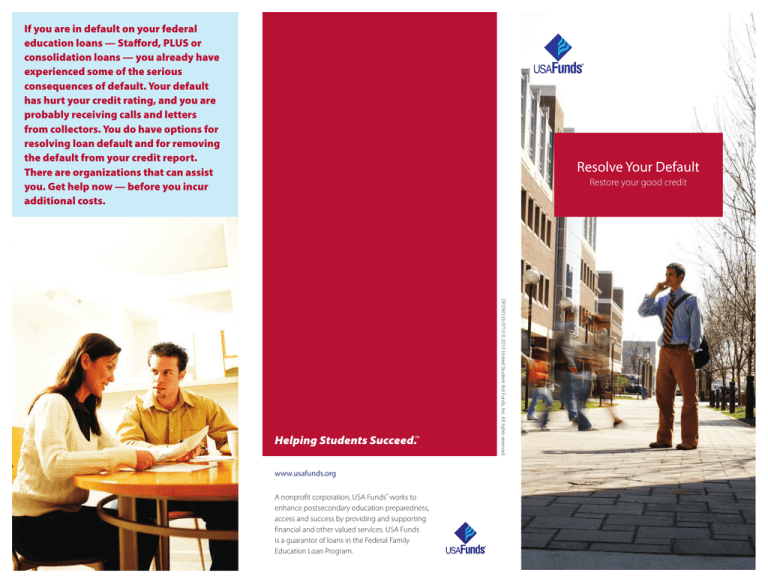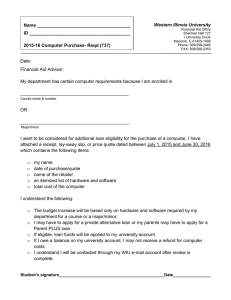If you are in default on your federal
advertisement

If you are in default on your federal education loans — Stafford, PLUS or consolidation loans — you already have experienced some of the serious consequences of default. Your default has hurt your credit rating, and you are probably receiving calls and letters from collectors. You do have options for resolving loan default and for removing the default from your credit report. There are organizations that can assist you. Get help now — before you incur additional costs. Resolve Your Default Restore your good credit DPDM133-0713 © 2013 United Student Aid Funds, Inc. All rights reserved. www.usafunds.org A nonprofit corporation, USA Funds® works to enhance postsecondary education preparedness, access and success by providing and supporting financial and other valued services. USA Funds is a guarantor of loans in the Federal Family Education Loan Program. Resolving your default If you are in default on a federal education loan, you can resolve your default and even restore your good credit. You should pursue one of these options for getting out of default: Payment in full. When you defaulted on your loans, the entire balance immediately became due. If at all possible, arrange to make payment in full. Repayment arrangements. Because most borrowers who are in default cannot afford to make payment in full, your loan’s guarantor, the collection agency to which your account has been assigned, or the U.S. Department of Education can establish repayment arrangements with you. Typically, these plans require that each of your installments at least cover the accruing interest and collection costs on your loans. Loan consolidation. Under certain circumstances, you can resolve your default by consolidating your outstanding loans. Once your consolidation loan is approved, your credit report will be updated to reflect that your defaulted loan is paid in full, although your credit report will continue to document that you previously defaulted on your loans. You then must make the required timely payments on your new consolidation loan. Loan rehabilitation. From the standpoint of restoring your good credit, loan rehabilitation is your best option. You must first make nine, voluntary, on-time monthly payments within a 10-month period. These payments can be reasonable and affordable, but typically must at least cover accruing interest and collection costs. After you have made your required monthly payments, your loan will be placed back in repayment, and the reporting of your default will be deleted from your credit report. You will be required to make payments until your loan is paid in full. Note that you may rehabilitate defaulted loans only once. Additional consequences of default Failure to resolve your education loan default really isn’t an option. If you don’t take action to cure your default, you may face the following additional consequences: Your credit rating continues to suffer. Federal law requires your default to be reported to national consumer reporting agencies. This notification will continue to harm your credit rating and likely will make it difficult — and more expensive — for you to obtain other types of consumer credit, such as a home mortgage or a car loan. Your wages may be garnished. If you fail to make arrangements to repay your loans and follow through by making your payments, your employer may be required to withhold a portion of your pay, which will be applied to your unpaid balance. You will incur additional costs. Collection costs, as specified by federal regulations, were added to your outstanding balance when you defaulted on your loan. If you fail to make payments on your loan, interest will continue to accrue on the unpaid balance. For example, if you default on $5,000 in student loans and fail to make a payment for two years, at the end of that period, the balance that you owe could grow to more than $7,000, including collection costs and additional interest. You may be sued. Your guarantor or the federal government may file a lawsuit seeking a civil judgment against you for the amount you owe. The debt doesn’t go away. Your unpaid loan will stay with you until you pay it back. With rare exceptions, federal education loans aren’t written off, and there is no statute of limitations associated with collection of federal education loans. Your guarantor, collection agencies or a unit of the federal government will continue to seek payment from you. Where to get help If you are in default on a loan with USA Funds®, contact the collection agency that manages your account. If you don’t know which agency manages your account, call (800) 331-2314. You also may obtain information about your account by visiting www.usafundsloansolutions.org. Your income tax refunds and other government benefit payments may be seized. If you are due a federal income tax refund or other federal payment, that payment may be seized to help satisfy the outstanding balance that you owe. In addition, some state governments seize state tax refunds or benefit payments due defaulted borrowers. If your loan is held by another student loan guarantor or the Department of Education, contact that organization for more information. If you don’t know which entity holds your loans, use the National Student Loan Data System Student Access website, www.nslds.ed.gov, to obtain that contact information. You won’t be able to receive additional federal student aid. If you wish to return to school, you will not be eligible for any additional federal student aid until you make arrangements to repay your defaulted loan. If your defaulted loan has been assigned to the U.S. Department of Education, call (800) 621-3115.







